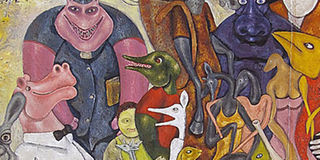Breaking News: At least 10 feared to have drowned in Makueni river
Heart of London, here we come

Class of 2011 by Anthony Okello. Photo/FRANK WHALLEY
What you need to know:
- Six artists --Patrick Mukabi, Beatrice Wanjiku, Bertiers, Shabu Mwangi, Richard Kimathi and Anthony Okello-- show at Cork Street in glittering Galleryland, London.
- The exhibition, arranged by Carol Lees of Nairobi’s One-Off gallery, opened on Thursday and will run for a further two weeks.
- For certain they will show visitors that dark, dynamic and disturbing work is being produced in this region.
East African art is again making its mark on the international scene.
This time Kenya takes a bow with an exhibition in the heart of London’s Galleryland — that expensive area just off New Bond Street in the capital’s West End.
Six artists are showing 23 works at the Gallery of African Art in Cork Street, the first time Kenyans have shown at this prestigious address.
The exhibition, arranged by Carol Lees of Nairobi’s One-Off gallery, opened on Thursday and will run for a further two weeks.
It includes works by Patrick Mukabi, Beatrice Wanjiku, Bertiers, Shabu Mwangi, Richard Kimathi and Anthony Okello.
Mukabi is showing his tin sheet cut-outs; the rest are paintings and mixed media pictures.
Among them is a particularly powerful group by Beatrice Wanjiku.
Wanjiku’s paintings include a reference to the lasting power and popularity of Albrecht Durer’s drawing Praying Hands… like Van Gogh’s Sunflowers, or the Mona Lisa, once seen, forever embedded in the psyche and liable to pop up unannounced from time to time.
'AS THOUGH TO CONCEAL A BLUSH'
Hers is a delicate x-ray hand (a remembrance perhaps of her Transition series) photocopied and collaged onto the paper, the slender finger bones held across the face — the softest suggestion of a pink skull — as though to conceal a blush.
With it are a few of her more recent offerings, dealing with mortality and grief. Not easy viewing you might think, any more than the visceral explosions of Francis Bacon, yet these are strangely lyrical works.
A tender remembrance of someone’s pain, probably her own, rather than angst.
However, her study Beauty and Ugliness, mixed media on paper, is more the stuff of nightmares, genuinely horrific… a hooded head, the mask ripped to reveal the jawbones, bared teeth and staring eyes. Another in the series shows a head, again hooded, but this time with full lips, blood red and pouting, the raw jawbone all too visible.
These are collages that literally strip us to the bone; reveal those parts of us we would rather remained concealed.
For certain they will show visitors that dark, dynamic and disturbing work is being produced in this region — exactly the qualities that attracted European artists to African tribal pieces in the first place, around the advent of Cubism in the 1900s.
Most of the works show too, that African art is strong and vigorous, not the debased dance for tourists that Bertiers (and many others) seems to delight in producing by the square metre.
ODDLY ENOUGH...
Oddly enough, Bertiers’ oeuvre of village life writ large and silly translates rather well in his metal sculptures — they strike me as incisive and genuinely witty; his paintings only as superficial squibs — but alas, London will be denied the pleasure of the former.
Shabu Mwangi’s group includes the ravishing Observer, last seen at Le Rustique restaurant in May; its lightly pencilled grid of glowing colours — those of the candidates in Kenya’s last general election — balancing the slumped figure described in washes of burnt umber that represents the nonplussed voter.
Richard Kimathi offers seven small figure studies, two of couples, five of people standing alone, wrapped in shawls that make them look like babies in swaddling cloths, except that babies probably would not have blue faces nor look quite so uncomprehending. These are intense, introverted works possessed of an inner stillness that makes them feel aloof.
Anthony Okello has sent three large paintings in his typically surrealist style, including Class of 2011, another satirical look at the build-up to Kenya’s last general election of 2013. It is of 15 or so animals, including hare, bull, fox, and something that could be a hippo or a pig, wearing a crisp white shirt and a smart bow tie.
There are reptiles, fish and birds.
These are the candidates, although who each animal represents, Okello is not telling. The metaphors are there for you to interpret as you will.
The whole thing works through a circular composition, its strong colours resounding against a pale straw background of faces, some smiling, some anguished: The hapless voters, I assume.
There is an Okello in the personal collection of C. Bendu Cooper, who owns the gallery that is hosting this show.
A Liberian, Mrs Cooper has already held a number of exhibitions of work from the continent, including paintings by the Ethiopian Wosene Worke Kosrof, a mixed show from Nigeria and, recently, a solo presentation by the Sudanese calligrapher Hassan Musa.
Now it is Kenya’s turn for the West End spotlight.
Mrs Cooper told me: “I want to expose artists from Africa to an international clientele.”
They already have one, of course — the international clientele that descends on Nairobi via NGOs, two-year contracts and the UN — but it will be interesting to gauge the reaction of the more focused view that visitors to Cork Street are likely to provide.
Frank Whalley runs Lenga Juu, a fine arts and media consultancy based in Nairobi.
This article was first published in the East African




